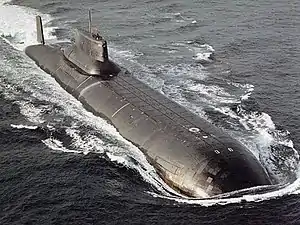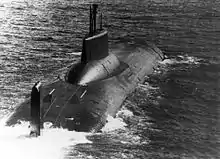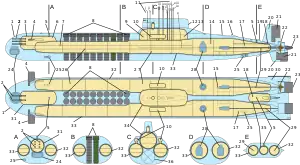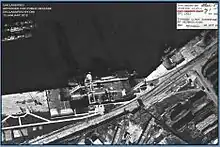Typhoon-class submarine
The Typhoon class, Soviet designation Project 941 Akula (Russian: Акула, meaning "shark", NATO reporting name Typhoon), is a class of nuclear-powered ballistic missile submarines designed and built by the Soviet Union for the Soviet Navy. With a submerged displacement of 48,000 tonnes,[1] the Typhoons are the largest submarines ever built,[3] able to accommodate comfortable living facilities for the crew of 160 when submerged for months on end.[4] The source of the NATO reporting name remains unclear, although it is often claimed to be related to the use of the word "typhoon" ("тайфун") by General Secretary Leonid Brezhnev of the Communist Party in a 1974 speech while describing a new type of nuclear ballistic missile submarine, as a reaction to the United States Navy's new Ohio-class submarine.[5]
 Akula-class SSBN profile | |
 Typhoon-class submarine making way | |
| Class overview | |
|---|---|
| Name: | Akula class |
| Builders: | Sevmash, designed by Rubin |
| Operators: | |
| Preceded by: | Delta class |
| Succeeded by: | Borei class |
| Built: | 1976–1986 |
| In service: | 1981–present |
| In commission: | 1981–1989 |
| Planned: | 7 |
| Completed: | 6 |
| Cancelled: | 1 |
| Active: | 1 |
| Laid up: | 2 |
| Retired: | 3 |
| General characteristics | |
| Type: | Ballistic missile submarine |
| Displacement: | |
| Length: | 175 m (574 ft 2 in) |
| Beam: | 23 m (75 ft 6 in) |
| Draught: | 12 m (39 ft 4 in) |
| Propulsion: |
|
| Speed: |
|
| Endurance: | 120+ days submerged[1] |
| Test depth: | 400 m (1,300 ft) |
| Complement: | 160 persons[1] |
| Armament: |
|
The Russian Navy cancelled its Typhoon modernization program in March 2012, stating that modernizing one Typhoon would be as expensive as building two new Borei-class submarines.[6] With the announcement that Russia has eliminated the last SS-N-20 Sturgeon SLBMs in September 2012, all the Typhoons have reached the end of service, with one exception, Dmitry Donskoy, which is armed with the more modern RSM-56 Bulava SLBM. [7][8]
Description
Besides their missile armament, the Typhoon class features six torpedo tubes designed to handle RPK-2 (SS-N-15) missiles or Type 53 torpedoes. A Typhoon-class submarine can stay submerged for 120 days[1] in normal conditions, and potentially more if deemed necessary (e.g., in the case of a nuclear war). Their primary weapons system is composed of 20 R-39 (NATO: SS-N-20) ballistic missiles (SLBM) with a maximum of 10 MIRV nuclear warheads each. Technically, Typhoons were able to deploy their long-range nuclear missiles while moored at their docks.[9]
Typhoon-class submarines feature multiple pressure hulls, similar to the World War II Japanese I-400-class submarine, that simplifies internal design while making the vessel much wider than a normal submarine. In the main body of the sub, two long pressure hulls lie parallel with a third, smaller pressure hull above them (which protrudes just below the sail), and two other pressure hulls for torpedoes and steering gear. This also greatly increases their survivability – even if one pressure hull is breached, the crew members in the other are safe and there is less potential for flooding.
The Typhoon is capable of traveling at 28 kn (52 km/h; 32 mph) underwater.[10]
History



The Typhoon class was developed under Project 941 as the Russian Akula class (Акула), meaning shark. It is sometimes confused with other submarines, as Akula is the name NATO uses to designate the Russian Project 971 Shchuka-B (Щука-Б)-class attack submarines. The project was developed with the objective to match the SLBM armament of Ohio-class submarines, capable of carrying 192 nuclear warheads, 100 kt each, but with significantly longer range. To accommodate this increase in range, Soviet SLBMs were substantially larger and heavier than their American counterparts (the R-39 Rif is more than twice as heavy as the UGM-96 Trident I; it remains the heaviest SLBM to have been in service worldwide). The submarine had to be scaled accordingly.[11]
In the early 1990s, there were also proposals to rebuild some of the Typhoon-class submarines to submarine cargo vessels for shipping oil, gas and cargo under polar ice to Russia's far flung northern territories. The submarines could take up to 10,000 tonnes of cargo on-board and ship it under the polar ice to tankers waiting in the Barents Sea. These ships – after the considerable engineering required to develop technologies to transfer oil from drilling platforms to the submarines, and later, to the waiting tankers – would then deliver their cargo world-wide.[12]
Six Typhoon-class submarines were built. Originally, the submarines were designated by hull numbers only. Names were later assigned to the four vessels retained by the Russian Navy, which were sponsored by either a city or company. The construction order for an additional vessel (hull number TK-210) was cancelled and never completed. Only the first of these submarines to be constructed, Dmitriy Donskoy, is still in active service with the Russian Navy, serving as a test platform for the Bulava (SS-NX-32) missile. Arkhangelsk (TK-17) and Severstal (TK-20) remain in reserve, not currently active with the Russian fleet. All the R-39 missiles have been retired. The Typhoons have been replaced by the Borei class since 2010-2011.
In late December 2008, a senior Navy official announced that the two Typhoon-class submarines, TK-17 Arkhangelsk and TK-20 Severstal, that are in reserve would not be rearmed with the new Bulava SLBM missile system. They could however be modified to carry cruise missiles or to lay mines, or could be used in special operations.[13] In late June 2009, the Navy Commander-in-Chief, Admiral Vladimir Vysotskiy told reporters that the two submarines would be reserved for possible future repairs and modernisation.[14] In May 2010, the Navy Commander-in-Chief reported that Russia's Typhoon-class submarines would remain in service with the Navy until 2019.[15] In September 2011, the Russian defense ministry decided to write off all Project 941 Akula nuclear-powered ballistic missile submarines until 2014. The reasons for decommissioning the Typhoon-class vessels are the restrictions imposed on Russia by the Strategic Arms Reduction Treaty and successful trials of new Borei-class submarine.[16]
Despite being a replacement for many types of submarines, the Borei-class submarines are slightly shorter than the Typhoon class (170 m (560 ft) as opposed to 175 m (574 ft)), and have a smaller crew (107 people as opposed to 160). These changes were in part designed to reduce the cost to build and maintain the submarines. In addition, the United States and Canada provided 80% of funds for scrapping the older Typhoon-class submarines, making it much more economical to build a new submarine.[17] However, according to other sources at the Russian defence ministry, no such decision has been made; in that case, the submarines would remain with the Russian Navy.[18]
In 2013, the state-run RIA Novosti news has announced that the Navy will scrap two Typhoons beginning in 2018. They will be TK-17 Arkhangelsk and TK-20 Severstal.[19] As of 2017, the decision about scrapping of TK-17 and TK-20 is still not certain.[20]
Units
| # | Name | Laid down | Launched | Commissioned | Fleet | Status |
|---|---|---|---|---|---|---|
| TK-208 | Dmitriy Donskoy | 30 June 1976 | 27 September 1979 | 23 December 1981 | Northern Fleet | In active service,[21][22] upgraded to project 941UM for use of Bulava missiles;[23] projected to remain in service until at least 2026.[24] |
| TK-202 | 22 April 1978 | 23 September 1982 | 28 December 1983 | Withdrawn from active service in June 1999, scrapped with the financial support of the U.S. | ||
| TK-12 | Simbirsk | 19 April 1980 | 17 December 1983 | 26 December 1984 | Withdrawn from active service in 1996, scrapped 2006–2008 | |
| TK-13 | 23 February 1982 | 30 April 1985 | 26 December 1985 | Withdrawn from active service in 1997, scrapped 2007–2009[25] | ||
| TK-17 | Arkhangelsk | 9 August 1983 | 12 December 1986 | 15 December 1987 | Northern Fleet | Decommissioned in 2006,[8] still in reserve[20] |
| TK-20 | Severstal | 27 August 1985 | 11 April 1989 | 19 December 1989[1] | Northern Fleet | Decommissioned in 2004,[8] still in reserve[20] |
| TK-210 | 1986 | Unfinished, scrapped on the way |
Timeline
TK-208 Dmitriy Donskoy (Typhoon #1)
- 10 February 1982: Entered 18th division (Zapadnaya Litsa), NOR.
- December 1982: Transferred from Severodvinsk to Zapadnaya Litsa.
- 1983-1984: Tests of D-19 missile complex. Commanders: A.V.Olkhovikov (1980–1984).
- 3 December 1986: Entered Navy Board of the Winners of the Socialist Competition.
- 18 January 1987: Entered MoD Board of Glory.
- 20 September 1989 – 1991: Repairs and refit at Sevmash to Project 941U. 1991 refit cancelled.
- 1996: Returned to 941U refit.
- 2002: Named Dmitriy Donskoy.
- 26 June 2002: End of refit.
- 30 June 2002: Start of testing.
- 26 July 2002: Entered sea trials, re-entered fleet, without missile system.
- December 2003: Sea trials; refitted to carry a new Bulava missile system. New missile system expected to be operational by 2005.
- 9 October 2005: Successfully launched SS-NX-30 Bulava SLBM from surface.
- 21 December 2005: Successfully launched SS-NX-30 Bulava SLBM from submerged position on move.
- 7 September 2006: Test launch of the Bulava missile failed after several minutes in flight due to some problems in the flight control system. The missile fell into the sea about a minute after the launch. The sub was not affected and was returning to Severodvinsk base submerged. Later reports blamed the engine of the first stage for the failure.
- 25 October 2006: Test launch of the Bulava-M missile in the White Sea failed some 200 seconds after liftoff due to the apparent failure of the flight control system.
- 28 August 2008: Underwent successful testing at the Sevmash shipyard in Severodvinsk, Arkhangelsk Oblast. More than 170 men worked with the Dmitriy Donskoy, 100 of them employed at the Sevmash plant and 70 at other companies.
- As of 2017, the submarine is still in active service.[21]
TK-17 Arkhangelsk (Typhoon #5)
- 19 February 1988: Entered 18th division (Zapadnaya Litsa) NOR.
- September 1991, damaged after a SLBM exploded in the launch silo.[26][27]
- 8 January–9 November 2002: Refit at Sevmash.
- In July 2002, crew petitioned Main Navy Headquarters to adopt the name Arkhangel'sk (renamed on 18 November 2002).
- Commander: 2002-2003 V.Volkov.
- 17 February 2004: Took part in military exercises with President Vladimir Putin aboard.
- In reserve since 2006, the fate of the submarine is unknown. The decision about its dismantling still has not been made.[20]Apparent proposal to convert to cruise missile role being considered in 2019 but deemed unlikely.[28]
TK-20 Severstal (Typhoon #6)
- 28 February 1990: Entered 18th division (Zapadnaya Litsa), NOR.
- 25 August 1996: Successfully launched SLBM
- November 1996: Successfully launched SLBM from the North Pole.
- 24 July 1999: Took part in parade on Navy Day in Severomorsk, NOR.
- November–December 1999 – distant cruise.
- 2001: named to Severstal.
- June 2001–December 2002: Repairs at Sevmash.
- Commander: A. Bogachev (2001).
- In reserve since 2004, the fate of the submarine is unknown. The decision about its dismantling still has not been made.[20]Apparent proposal to convert to cruise missile role being considered in 2019 but deemed unlikely.[29]
Photos
Satellite photos

- Two side-by-side (TK-20 and TK-17) at 64.5751°N 39.7701°E
Interior photos
- In 2009 a blogger posted dozens of photos of the interior of a Typhoon submarine at Nerpichya Naval Base,[30] perhaps TK-12 or TK-13 based on the state of decay, claiming the photos were taken in 2004.[31] That pair of aging submarines were decommissioned several years prior, in 1996 and 1997.
Notable appearances in media

Probably the best-known fictional Typhoon-class submarine is the stealth equipped Red October, the subject of the Tom Clancy novel The Hunt for Red October and its 1990 movie adaptation, starring Sean Connery as the fictional Captain Marko Ramius.
The 2001 documentary Mission Invisible about the Russian submarine Severstal was produced by Corona Films for Discovery Channel with the participation of ZED, France 5, ZDF, RTBF, TV5 Monde and the Scottish Screen Fund.[32][33]
In 2008 National Geographic released a documentary about the scrapping of one of the Typhoons in the series Break It Down.[34] This boat is TK-13, which was scrapped over the time period 2007–2009.
See also
Notes
- Podvodnye Lodki, Yu.V. Apalkov, Sankt Peterburg, 2002, ISBN 5-8172-0069-4
- Only 20 torpedoes and/or AShMs can be loaded.
- "Submarine Milestones - Largest Subs". National Geographic. 1981-12-12. Archived from the original on 2011-06-04. Retrieved 2011-08-14.
- Waller D.C. (March 2001). "Essay - The Hunt for Big Red" (PDF). Wake Forest Magazine. 48 (3): 28–31. Archived (PDF) from the original on 12 October 2009. Retrieved 13 October 2009.
- Hitchens, Theresa (2001). "Get a policy, please". Bulletin of the Atomic Scientists. 57 (2001): 21–23. doi:10.2968/057001008.
- "Russian Navy Abandons Akula Modernization Project". Russian Navy. 2012-07-03. Archived from the original on 2013-02-01. Retrieved 2012-09-26.
- https://www.forbes.com/sites/hisutton/2020/08/23/last-typhoon-can-the-worlds-largest-submarine-still-destroy-the-world/?sh=350497736ec2
- "Russia, USA Liquidated Entire Class of Ballistic Missiles". Russian Navy. 2012-09-17. Archived from the original on 2012-10-13. Retrieved 2012-09-26.
- "941 TYPHOON – Russian and Soviet Nuclear Forces". Federation of American Scientists. Archived from the original on 2011-08-11. Retrieved 2011-08-14.
- "The Massive Soviet Sub That Inspired 'Hunt For Red October'". Foxtrot Alpha. Archived from the original on 2019-01-14. Retrieved 2019-01-13.
- "World Naval Developments: The Typhoon Saga Ends | U.S. Naval Institute". www.usni.org. Archived from the original on 2017-08-11. Retrieved 2017-08-11.
- "Typhoon Subs to Ship Oil and Gas". Bellona.org. 14 May 2003. Archived from the original on 20 September 2017. Retrieved 13 July 2017.
- "Russia to hold more test launches of Bulava ICBM in 2009". RIA Novosti. 16 December 2008. Archived from the original on 22 January 2011. Retrieved 14 August 2011.
- Олег Ласточкин (26 June 2009). "Стратегические АПЛ "Тайфун" останутся в боевом составе ВМФ РФ | Оборона и безопасность". RIA Novosti. Archived from the original on 29 June 2009. Retrieved 14 August 2011.
- "Russia set to keep Typhoon class nuclear subs until 2019". RIA Novosti. 7 May 2010. Archived from the original on 7 October 2011. Retrieved 14 August 2011.
- "Russia To Dismantle World's Biggest Subs". Russian Navy. Archived from the original on 2011-10-06. Retrieved 2011-09-29.
- "Russia's gigantic Typhoon submarines to be scrapped". Pravda. 29 September 2011. Archived from the original on 7 October 2014. Retrieved 3 March 2014.
- "No plans to retire Typhoon class subs soon – Russian military". RIA Novosti. 2011-09-30. Archived from the original on 2012-01-18. Retrieved 2012-07-22.
- "Russia to Scrap World's Biggest Nuclear Subs". RIA Novosti. 2013-05-21. Archived from the original on 2013-07-16. Retrieved 2013-08-17.
- "Решение об утилизации самых больших в мире АПЛ "Акула" пока не принято". ria.ru. 2016-11-11. Archived from the original on 2017-09-21. Retrieved 2017-07-13.
- "Look who's coming; world's largest submarine en route south". Archived from the original on 2017-06-13. Retrieved 2017-07-13.
- ""Дмитрий Донской" прибыл в Североморск". 27 May 2017. Archived from the original on 16 July 2017. Retrieved 13 July 2017.
- "25.02.10 "Булаву" впервые испытают на АПЛ проекта "Борей" - Военный паритет". Militaryparitet.com. Archived from the original on 2013-02-06. Retrieved 2012-07-22.
- https://tass.com/defense/1244995
- Text: Trude Pettersen (2009-06-04). "One sub out, another one in". BarentsObserver. Archived from the original on 2012-02-15. Retrieved 2011-08-14.
- "Captain who saved White Sea from nuclear disaster dies at 67". Archived from the original on 2018-02-03. Retrieved 2018-02-04.
- @JosephHDempsey (30 April 2015). "Damage to #Russia Navy TK-17 Typhoon SSBN after missile explosion during 1991 training launch h/t @russianforces #TBT" (Tweet) – via Twitter.
- https://nationalinterest.org/blog/buzz/why-russia-packing-its-old-typhoon-class-submarines-hundreds-cruise-missiles-102302
- https://nationalinterest.org/blog/buzz/why-russia-packing-its-old-typhoon-class-submarines-hundreds-cruise-missiles-102302
- "Nerpichya Naval Base - Wikimapia". wikimapia.org. Archived from the original on 2016-03-04. Retrieved 2015-11-07.
- "ru_submarine: тип 941 акула она же typhoon: самая большая лодка в мире". Ru-submarine.livejournal.com. Archived from the original on 2013-04-23. Retrieved 2013-08-17.
- "Mission Invisible 52' - Television - Distribution - ZED". www.zed.fr. Archived from the original on 2016-09-20. Retrieved 2016-07-30.
- "Full record for 'AUF UNSICHTBARER MISSION MISSION INVISIBLE' (8144) - Moving Image Archive catalogue". National Library of Scotland. Archived from the original on 2016-08-17. Retrieved 2016-07-30.
- "Break It Down - Nuclear Submarine". National Geographic. Archived from the original on 2012-10-21. Retrieved 2010-08-23.
External links
| Wikimedia Commons has media related to Typhoon class submarines. |